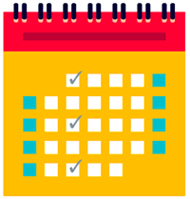EXTENDED-CARE MARKETING EDITION
 Sure, you can post a blog without featuring an image. But should you? NO. Relevant visual content in your extended-care blog entries strategically enhances your written content. Moreover, studies show that images (photos, videos, infographics, charts, quote cards) boost your content’s page views significantly—as much as 94% according to Content Marketing Institute.
Sure, you can post a blog without featuring an image. But should you? NO. Relevant visual content in your extended-care blog entries strategically enhances your written content. Moreover, studies show that images (photos, videos, infographics, charts, quote cards) boost your content’s page views significantly—as much as 94% according to Content Marketing Institute.
Photos and videos are the easiest for extended-care organizations (such as rehabilitation centers and skilled nursing care facilities) to capture. Here, we’ll focus on those images; next week, infographics, charts and quote cards!
When mapping out your editorial calendar, think about how photos or videos can accompany blog entries. For example:
• “Testimonial from an outpatient rehab patient” can include an original photo of the patient with his physical therapist.
• “Music engages dementia patients” can feature an original video taken at your facility.
• “Tasting food again!” which discusses how residents benefit from being weaned from ventilator dependency, can include a free public domain image of flavored ices (one of the first foods given during the weaning process).
Here are some steps and tips to help you unearth interesting images for moderate costs or for free:
Use original photos and videos. Your facility is bursting with visual content just waiting to be captured. Cost prohibits frequent (or any!) use of a professional photographer or videographer, but you and your staff have access to smartphones and your facility may even have a digital camera. Here are some tips on capturing great original photos and videos.
• Since staff taking images aren’t professionals, provide them with a tripod (don’t spend more than $100 for a simple one) to avoid blurry photos from unsteady hands or fast-moving footage.
• Focus on a few people rather than a crowd. Tell your story through the personal interactions.
• Even if you’re showing off a newly renovated area, always include people in the shot for warmth and interest.
• Remove or reposition excess background and foreground items.
• Take images as much as possible in areas filled with natural light. However, don’t place your subjects directly in front of a window.
• Don’t use zoom. Instead move closer to your subject.
• Take numerous photos, and both long and short videos, so you have lots of choices.
• Don’t delete the raw photos and footage until they are uploaded to your facility’s image archives where the next step would be editing the featured photo or footage.
• Ask your legal department or administration what your organization’s policy is on getting signed photo release forms.
Edit original photos and videos. Once you decide on a photo for your blog entry, look at it closely to see it if needs to be retouched (perhaps, lightened to ensure that faces are easily visible or cropped to eliminate distracting background elements). Photographers and designers often retouch photos. Likewise, videographers take their raw footage and edit it to better and succinctly tell the story by adding cuts, text and more.
If you don’t want to purchase photo-editing software such as Photoshop, search the Internet for free photo-editing software. For example, gimp offers a free and open source image editor that is considered user friendly. Many free editing apps for videos taken with a smartphone can be downloaded from the Internet, too. To find a free app that suits your needs, search free editing apps for videos taken with phone.
Use free stock photos. Search free public domain images. Check out the search results and read the site’s fine print to ensure no attributes are required for use (for instance, that you don’t have to use a photo credit line) and that model releases have been signed. Pixabay is one of our favorites. Download the largest free file size so you can potentially feature it in your print efforts. You can also search free vector images or free clip art images for more image options.
Consider paying a small fee for a stock photo. There are numerous sites where a professional-quality image can be purchased for as little as $5 to $10 and sometimes less. Some of our favorites are thinkstockphoto, shutterstock and istockphoto. Again, download the largest file size so you can potentially feature it in your print efforts.
REMEMBER: Your time and cost investment in your original visual content will reap rewards because images can be used again and again throughout your other social media efforts and possibly print efforts.
> If you need help building or bettering a blog or using photos and videos, give Lazzaro Designs a call or shoot us an email.
> Coming soon: How to use charts, infographics and quote cards.
EXTENDED-CARE MARKETING EDITION
You’ve got your target audience, you understand content marketing. Now, you have to blog regularly. Why? Studies have shown that organizations that blog three to five times a month have more traffic than those that don’t. As important as frequency is, however, consistency is even more so. Once your readers become accustomed to a consistent schedule, they will not want to be disappointed.
There is nothing more discouraging—nor, does it reflect well on the organization—than going to a blog and seeing that the last entry was spring of 2014. To avoid that fate, here’s how you can build an editorial calendar that keeps you on track:
 • An editorial calendar maps out topics, writers, deadlines and publishing dates. With whatever system works for you, be sure to include those key elements.
• An editorial calendar maps out topics, writers, deadlines and publishing dates. With whatever system works for you, be sure to include those key elements.
• Map out the next three months’ worth of blogging content. You can be flexible and change things up as you continue to brainstorm great entries, but having a three-month plan ensures that you’ll get those entries out reliably.
• Make like an editor and assign stories to key staff members and give them reasonable deadlines. One nursing home we know does an excellent job at this with exercise tips written by their rehab team, food tips by their nutritionists, and so forth.
• Schedule your entries to automatically post at the appropriate times. All blogging templates allow for this function.
• Dedicate one day a month to your blog. This is a good way to review the upcoming calendar, write and/or edit entries and continue to plan the following three months.
> If you need help building a blog or creating an editorial calendar, give Lazzaro Designs a call or shoot us an email.
> Coming soon: Ways you can “bump up” the effectiveness of your blog: writing and design tips, how to use photos and infographics, as well as setting yourself up for an e-marketing campaign.
EXTENDED-CARE MARKETING EDITION
Now that you have a good sense who your target audience is, let’s get them engaged with your extended-care organization blog. First step, start thinking about your audience and your character personas as “readers.” What do readers want? Content marketing.
 Content marketing are buzzwords you may have heard. Don’t let the phrase confuse you. It simply means providing your readers with relevant, engaging content that they can use or that they might be searching for on the Internet. Why? Your audience is more likely to reward you with their business and their loyalty, and you distinguish yourself from your competitors.
Content marketing are buzzwords you may have heard. Don’t let the phrase confuse you. It simply means providing your readers with relevant, engaging content that they can use or that they might be searching for on the Internet. Why? Your audience is more likely to reward you with their business and their loyalty, and you distinguish yourself from your competitors.
Here are some examples on how to create content marketing for two key audiences (you may have others):
1. Adult children, who are balancing the demands of career, their own children and their aging parents, will want to read entries such as: Ways to work through differing opinions among siblings on how to care for aging parents, tips for caring for the caregiver, how to stay engaged with a parent in an extended-care facility when you live far away.
2. Hospital discharge planners who want to make referrals that will please their patients and families will want to read entries such as: Testimonials from satisfied residents and families, those written by your on-staff experts about best practices in their fields (for instance, working with dementia patients, getting a short-term joint replacement patient rehabilitated), and news about your staff being on the cutting edge of extended care, for instance, mentions of awards won or your staff presenting to conferences.
Here are more tips to consider:
• Include meatier pieces. There is great debate in the blogging/marketing world on the “right” number of words for an entry. One thing everyone agrees on, while a lengthier entry gets more search-engine attention, quality counts. Our general recommendation: Make sure your entry is at least 250 words long and then take as many words beyond that as you need to provide your readers useful content.
• Do not include a litany of services. Your audience can find your services elsewhere on your website. They come to your blog to get useful content.
• Think outside the box. Realize that Debbie Discharge Planner is also releasing patients to home care. She’s concerned with avoiding hospital readmissions. As a leader in extended-care of similar patients, it is appropriate for you to provide her with content that helps her address this concern. For instance, write an entry on how to better educate patients regarding at-home self-care. In this way, you can speak to Debbie’s concerns even if they don’t immediately involve her sending homebound patients your way. In the meantime, you are building trust with her so that when she does make a long-term extended-care referral, she may more naturally think of your facility.
• Include a call to action. This is the classic last line that tells your readers to do something. For example, you may say, “For more information on our facility and how we might be able to help your family’s extended-care needs, contact us.” The “contact us” phrase should be hyperlinked to your contact page elsewhere on your website. This is one way that a blog entry can turn a reader into a client.
> If you need help building a blog or creating content marketing, give Lazzaro Designs a call or shoot us an email.
> Coming soon: Ways you can “bump up” the effectiveness of your blog: writing and design tips, how to use photos and infographics, as well as setting yourself up for an e-marketing campaign.
EXTENDED-CARE MARKETING EDITION
Now that you know why a blog is a great, often under-used marketing tool, it’s time for the how-tos. Whether you’re enlivening a news page, reviving a blog or starting from scratch, let’s consider the fundamentals, starting with your audience.
 It’s important to target your audience, both those who may already be reading and those you want to be reading. Why? By targeting your audience, you will create blog entries that are interesting and relevant to readers, thereby building loyalty and the next step, potential referrals (including self-referrals).
It’s important to target your audience, both those who may already be reading and those you want to be reading. Why? By targeting your audience, you will create blog entries that are interesting and relevant to readers, thereby building loyalty and the next step, potential referrals (including self-referrals).
Here are three steps for how to target your audience:
1. Create reader personas with names and faces and detailed profiles so you have a vision of exactly whom you are talking to when you’re building your blog. Like characters in a play, your reader personas serve as a shorthanded way of thinking about which entries appeal to which reader. For instance, if you are especially interested in gaining self-referrals and building relationships with families, your blog’s target audience is probably adult children. But push that further. What does that adult child look like? She is more than likely an adult daughter. Let’s call her Gabby Grown Daughter. How old is she? Where does she live? Where do her parents live? Does Gabby work? Have children? Is she married? The more you flesh out who Gabby Grown Daughter is, the more you’ll be able to target your blog’s content and your marketing to her in a meaningful way.
2. Focus on actual people, not just organizations. You might want to target instead important referrers, such as discharge planners at your local hospital, for instance. By naming your reader—Debbie Discharge Planner—you keep your focus on the warm-blooded human, not the organization she represents. That being said, consider your reader’s position in the organization. What is Debbie’s department? Her title, role and responsibilities? Build her character and then build a few more for other key potential referrers.
 3. Make notes on what your reader would find useful. What are your readers’ concerns? What do they care about? What do they want to do better? What might they search the Internet for? Gabby Grown Daughter might be concerned about balancing the opinions of her siblings when it comes to Dad’s care. Debbie Discharge Planner might be concerned with reducing her hospital readmissions rate. When you encounter real-life examples of Gabby or Debbie and hear their concerns or their questions, jot them down in your “blog topics” file.
3. Make notes on what your reader would find useful. What are your readers’ concerns? What do they care about? What do they want to do better? What might they search the Internet for? Gabby Grown Daughter might be concerned about balancing the opinions of her siblings when it comes to Dad’s care. Debbie Discharge Planner might be concerned with reducing her hospital readmissions rate. When you encounter real-life examples of Gabby or Debbie and hear their concerns or their questions, jot them down in your “blog topics” file.
> If you need help building a blog or targeting your audience, give Lazzaro Designs a call or shoot us an email.
> Coming soon: Ways you can “bump up” the effectiveness of your blog: writing and design tips, how to use photos and infographics, as well as setting yourself up for an e-marketing campaign.
 Sure, you can post a blog without featuring an image. But should you? NO. Relevant visual content in your extended-care blog entries strategically enhances your written content. Moreover, studies show that images (photos, videos, infographics, charts, quote cards) boost your content’s page views significantly—as much as 94% according to Content Marketing Institute.
Sure, you can post a blog without featuring an image. But should you? NO. Relevant visual content in your extended-care blog entries strategically enhances your written content. Moreover, studies show that images (photos, videos, infographics, charts, quote cards) boost your content’s page views significantly—as much as 94% according to Content Marketing Institute.
 • An editorial calendar maps out topics, writers, deadlines and publishing dates. With whatever system works for you, be sure to include those key elements.
• An editorial calendar maps out topics, writers, deadlines and publishing dates. With whatever system works for you, be sure to include those key elements. Content marketing are buzzwords you may have heard. Don’t let the phrase confuse you. It simply means providing your readers with relevant, engaging content that they can use or that they might be searching for on the Internet. Why? Your audience is more likely to reward you with their business and their loyalty, and you distinguish yourself from your competitors.
Content marketing are buzzwords you may have heard. Don’t let the phrase confuse you. It simply means providing your readers with relevant, engaging content that they can use or that they might be searching for on the Internet. Why? Your audience is more likely to reward you with their business and their loyalty, and you distinguish yourself from your competitors. It’s important to target your audience, both those who may already be reading and those you want to be reading. Why? By targeting your audience, you will create blog entries that are interesting and relevant to readers, thereby building loyalty and the next step, potential referrals (including self-referrals).
It’s important to target your audience, both those who may already be reading and those you want to be reading. Why? By targeting your audience, you will create blog entries that are interesting and relevant to readers, thereby building loyalty and the next step, potential referrals (including self-referrals). 3. Make notes on what your reader would find useful. What are your readers’ concerns? What do they care about? What do they want to do better? What might they search the Internet for? Gabby Grown Daughter might be concerned about balancing the opinions of her siblings when it comes to Dad’s care. Debbie Discharge Planner might be concerned with reducing her hospital readmissions rate. When you encounter real-life examples of Gabby or Debbie and hear their concerns or their questions, jot them down in your “blog topics” file.
3. Make notes on what your reader would find useful. What are your readers’ concerns? What do they care about? What do they want to do better? What might they search the Internet for? Gabby Grown Daughter might be concerned about balancing the opinions of her siblings when it comes to Dad’s care. Debbie Discharge Planner might be concerned with reducing her hospital readmissions rate. When you encounter real-life examples of Gabby or Debbie and hear their concerns or their questions, jot them down in your “blog topics” file.